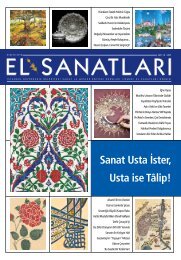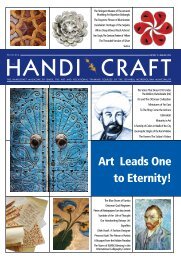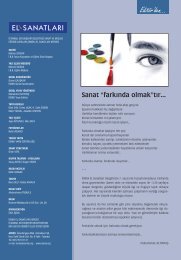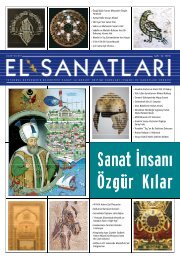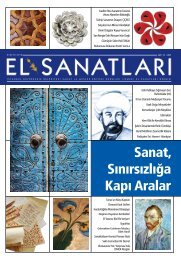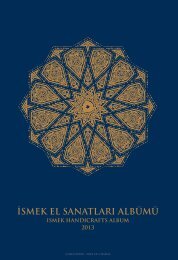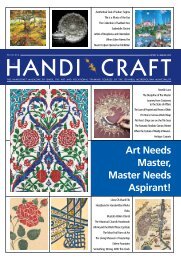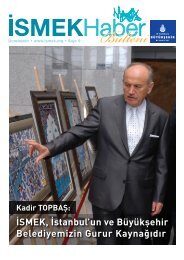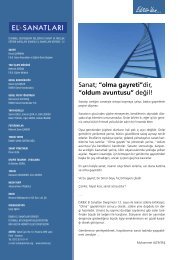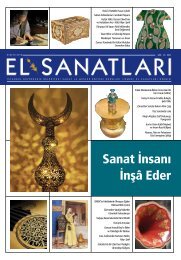Download Link - Ä°SMEK
Download Link - Ä°SMEK
Download Link - Ä°SMEK
You also want an ePaper? Increase the reach of your titles
YUMPU automatically turns print PDFs into web optimized ePapers that Google loves.
children of poor families. It’s said that he bumps into a<br />
student who hasn’t been coming to lessons a few days<br />
with a valid reason. The student explains to his teacher<br />
the situation he’s in. Hafiz Osman’s reaction is an<br />
unexpected one; he gets off his steed, sits on a rock on<br />
the side and says to the student: “Come, let’s see what<br />
you’ve done for your lessons.”<br />
Hilye-i Sheriff, Showing Sincerity<br />
They say that “What is to be, will be.”. If something<br />
good is going to happen, there are reasons for it to<br />
happen. Something happens; something follows it and<br />
so on. Hafız Osman’s love for religion and the Prophet<br />
has been one of his reasons.<br />
Hilye, which means “a piece of jewelry”, becomes a term<br />
in “Hilye-i Sherriff” and “Hilye-i Nebevî”. Writings that<br />
describe the Prophet’s appearance and manners are called<br />
“Hilye-i Sherriff”. Muslim artists, out of respect, have<br />
refrained from drawing the Prophet’s picture. This has<br />
caused Hilye-i Sherriff’s to be written for people who<br />
haven’t been able to see the Prophet in person. When<br />
the Prophet’s daughter, Hz. Fatima realized that her father<br />
was going to pass away, she was so sad. So our<br />
Prophet said to Hz. Ali (Hz. Fatima’s husband): “Write<br />
my Hilye. Whoever reads it will feel like they’ve seen me.<br />
“The Hilya-i Sharifa, which was designed in the free form and is almost like<br />
a picture, The Sadberk Hanım Museum, the 18th Century.”<br />
Hafiz Osman, who had an extremely humble personality,<br />
did not care for the fame brought from his masterpiece<br />
writings, being a teacher at the palace and<br />
his well known fame; because mastery of calligraphy<br />
wasn’t a goal for him. Calligraphy and his mastery at it<br />
were mediums to take him to the true goal. This knowledge<br />
led him to being interested in Sufism. He went to<br />
Sunbul Efendi’s religion school’s teacher Seyyid Aladdin<br />
Efendi. Both his hand and his heart are cleansed of rust<br />
with the help of the masters at the school.<br />
This religious education raises him even more in the eyes<br />
of the folk. He gets more students, he gets people from<br />
far away visiting to see his work and join his lessons. He<br />
gives two days a week to his students. One day is for<br />
the children of rich families, the other for the talented<br />
The first known Hilye writer was Tirmizi, who wrote<br />
“Şemail-i Nebi”. The first person to introduce Hilye-i<br />
Sherriff with calligraphy was Hafiz Osman Efendi. For<br />
centuries, Hilye’s were small, foldable books; to be carried<br />
in pockets. In 1690, Hafiz Osman made one on a<br />
tablet. Hafiz Osman’s oldest known pocket Hilye-i Sherriff<br />
was written in 1668. It was considered the first Hilye<br />
in history, and is still used today. After this, Hafiz Osman<br />
wrote the Hilye told by Hz. Ali, which says:<br />
“Hz. Ali (may Allah bless him), when explaining the<br />
Prophet’s (may Allah bless him) appearance, he says:<br />
“The Prophet is not too tall, not too short, but medium<br />
height. His hair was neither curly, nor straight, but between<br />
them. He had a round face, white skin, big, black<br />
eyes and long eyelashes. He had big bones and his shoulders<br />
were broad. His chest to his stomach was hairless.<br />
His palms and soles were plump. When he walked,<br />
he walked as calmly as if he was walking downhill.<br />
When he looked to his sides, he turned with his entire<br />
body. Between his shoulders was a “seal of prop-<br />
30



